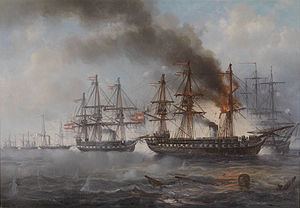Date 9 May 1864 Combatants Prussia, Austrian Empire | Result Tactical Danish victory | |
 | ||
17 killed37 wounded 37 killed93 woundedFlagship heavily damaged by fire Similar Second Schleswig War, Battle of Mysunde, Battle of Dybbøl, Battle of Sankelmark, Battle of Jasmund | ||
Battle of heligoland 1864
The Battle of Heligoland (or Helgoland) was fought on 9 May 1864, during the Second War of Schleswig between the navy of Denmark and the navy of Austria. The latter's ally, Prussia, sent support vessels but they played no part due to their arrival after the battle, which took place south of the then-British North Sea island of Heligoland where the previous 1849 sea battle had occurred.
Contents
When the Danish forces had caused the flagship of the Austrian commander, Freiherr von Tegetthoff, to catch fire, he withdrew his squadron to neutral waters around Heligoland. It was the last significant naval battle fought by squadrons of wooden ships and also the last one involving Denmark.
Although the battle ended with a tactical victory for Denmark (although the Austrians say it was a draw), it had no impact on the outcome of the war. A general armistice came into effect on 12 May, and Denmark had lost the war.
The battle
As the Danish squadron approached from the north, it sighted the British frigate Aurora at about 10 a.m. and soon afterwards five more ships to the Southwest. The two squadrons approached each other, and the Austrian screw-driven Schwarzenberg opened fire at 13.15 p.m. The Danes returned fire when the distance had closed. When Austrian Admiral Tegetthoff altered course to the West in an effort to "cross the T", Suenson turned to port. With the Prussian gunboats unable to keep pace and now far behind, the Austrian and Danish squadrons passed each other at a distance of about 1 nautical mile (1.9 km), exchanging furious fire. Tegetthoff turned about so as to prevent the gunboats being cut off, and both flotillas then sailed on a parallel course southwest, continuing to battle each other. The Danish Niels Juel duelled with Schwarzenberg, while the Danish Jylland and Hejmdal concentrated on the Austrian Radetzky. The Prussian gunboats were at this point too far away to play a role.
At about 15.30 p.m., Schwarzenberg caught fire and whilst this was quickly brought under control was unable to continue. Tegetthoff broke off the encounter and took his ships into the neutral waters near Heligoland. Aurora had observed the action and stood ready to protect the neutrality of the British Heligoland waters, so that Suenson, aware of the approaching Prussian gunboats, had to abandon any pursuit at about 16.30 p.m.
Aftermath
Suenson waited outside the British zone of 3 nautical miles (5.6 km), but the Austrian-Prussian squadron was able to escape during the night to Cuxhaven at the mouth of the Elbe. With the armistice set to come into effect on 12 May, Suenson was ordered back to Copenhagen, thus ending the naval blockade.
In Denmark as in Austria, the outcome of the battle was regarded as a victory. The Danish squadron was enthusiastically welcomed in Copenhagen, while in Austria, Tegetthoff was awarded with his promotion to rear admiral. He subsequently led the reform of the Austrian naval establishment. The refitted Swarzenberg subsequently took part in the Austrian naval victory at the Battle of Lissa two years later.
The frigate Jylland is today located in a drydock in a maritime museum in Ebeltoft, Denmark.
Order of battle
Denmark (Captain Edouard Suenson)
Austria (Captain Wilhelm Freiherr von Tegetthoff)
Prussia
Memorials
There is a memorial commemorating fallen Austrian sailors and marines from the battle, in a park in Altona, Hamburg, Germany.
In Copenhagen, at Nyboder, there is a monument commemorating Edouard Suenson who led the Danish forces in the battle.
